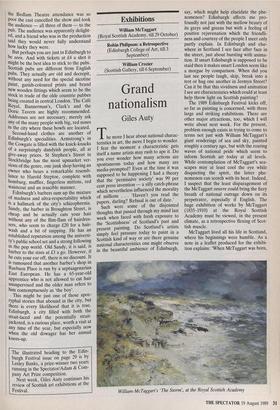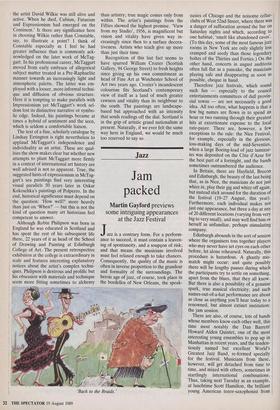Exhibitions
William McTaggart (Royal Scottish Academy, till 29 October) Robin Phffipson: a Retrospective (Edinburgh College of Art, till 3 September) William Crozier (Scottish Gallery, till 6 September)
Grand nationalism
Giles Auty
The more I hear about national charac- teristics in art, the more I begin to wonder. I fear the moment a characteristic gets itself a name artists may rush to ape it. Do you ever wonder how many actions are spontaneous today and how many are media-prompted? Even at the time it was supposed to be happening I had a theory that the 'permissive society' was 99 per cent press invention — a silly catch-phrase which nevertheless influenced the morality of millions . . . 'Haven't you read the papers, darling? Refusal is out of date.' Such were some of the disjointed thoughts that passed through my mind last week when faced with fresh exposure to the `Scottishness' of Scotland's past and present painting. Do Scotland's artists simply feel pressure today to paint in a Scottish kind of way or are there genuine national characteristics one might observe in the beautiful ambience of Edinburgh, say, which might help elucidate the phe- nomenon? Edinburgh affects me pro- foundly not just with the mellow beauty of its greys and greens but with a feeling of positive rejuvenation which the friendli- ness and courtesy of the people I meet only partly explain. In Edinburgh and else- where in Scotland I see face after face in the street, just about bursting with anima- tion. If smart Edinburgh is supposed to be staid then it makes smart London seem like a morgue by comparison. When did you last see people laugh, skip, break into a trot or hug one another in Jermyn Street? Can it be that this vividness and animation I see are characteristics which could at least help throw light on Scottish painting?
The 1989 Edinburgh Festival kicks off, so far as painting is concerned, with three large and striking exhibitions. There are other major attractions, too, which I will write about next week. For the present, problem enough exists in trying to come to terms not just with William McTaggart's giant renderings of sea and sky, painted roughly a century ago, but with the roaring waves of national pride which seem to inform Scottish art today at all levels. While contemplation of McTaggart's sea- scapes may at least cool the eye while disquieting the spirit, the latter phe- nomenon can scorch with its heat. Indeed, I suspect that the least disparagement of the McTaggart oeuvre could bring the fiery breath of national outrage down on its perpetrator, especially if English. The huge exhibition of works by McTaggart (1835-1910) at the Royal Scottish Academy must be viewed, in the present climate, as a retrospective flexing of Scot- tish muscle.
McTaggart lived all his life in Scotland, where his beginnings were humble. As a note in a leaflet produced for the exhibi- tion explains: 'When McTaggart was born, William•McTaggart's 'The Storm', at the Royal Scottish Academy the artist David Wilkie was still alive and active. When he died, Cubism, Futurism and Expressionism had emerged on the Continent.' Is there any significance here in choosing Wilkie rather than Constable, say, to illustrate a point? I think of Constable especially as I feel he had greater influence than is commonly ack- nowledged on the later work of McTag- gart. In his professional career, McTaggart moved from early embrace of allegorical subject matter treated in a Pre-Raphaelite manner towards an increasingly light and atmospheric palette. The latter was em- ployed with a looser, more informal techni- que and diffusion of obvious structure. Here it is tempting to make parallels with Impressionism yet McTaggart's work sel- dom lost its distinctive narrative or symbo- lic edge. Indeed, his paintings became at times a hybrid of sentiment and the seen, which is seldom a comfortable liaison.
The text of a fine, scholarly catalogue by Lindsay Errington is right nevertheless to applaud McTaggart's independence and individuality as an artist. These are qual- ities the show makes clear but whether new attempts to plant McTaggart more firmly in a context of international art history are well advised is not so apparent. True, the suggested hints of expressionism in McTag- gart's sea paintings find very interesting visual parallels 50 years later in Oskar Kokoschka's paintings of Polperro. In the end, historical significance must depend on the question: 'How well?' more heavily than just on `When?' — but this is not the kind of question many art historians feel competent to answer.
Although Robin Philipson was born in England he was educated in Scotland and has spent the rest of his subsequent life there, 22 years of it as head of the School of Drawing and Painting at Edinburgh College of Art. The present retrospective exhibition at the college is extraordinary in scale and features interesting explanatory notices about the artist's complex techni- ques. Philipson is dextrous and prolific but his obsession with materials and technique seem more fitting sometimes to alchemy than artistry; true magic comes only from within. The artist's paintings from the Fifties showed the highest promise. `View from my Studio', 1956, is magnificent but vision and vitality have given way in- creasingly since then to a surface decora- tiveness. Artists who teach give up more than just their time Recognition of this last fact seems to have spurred William Crozier (Scottish Gallery, 94 George Street) to fresh heights since giving up his own commitment as head of Fine Art at Winchester School of Art two years ago. Crozier's incandescent colourism fits Scotland's contemporary view of itself as a land of much greater rawness and vitality than its neighbour to the south. The paintings are landscape- based but approached with an intensity that sends readings off the dial. Scotland is in the grip of artistic grand nationalism at present. Naturally, if we ever felt the same way here in England, we would be much too reserved to say so.



















































 Previous page
Previous page